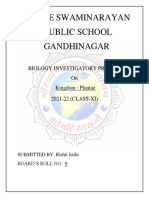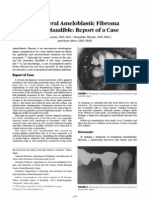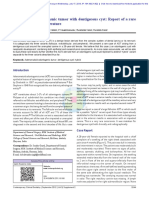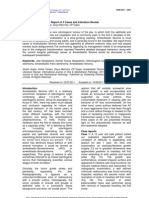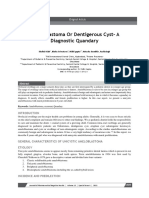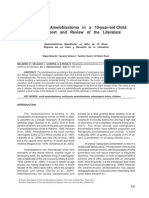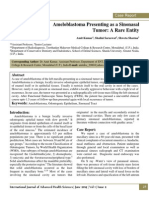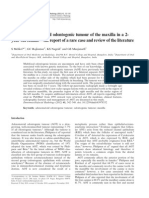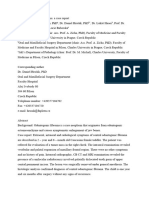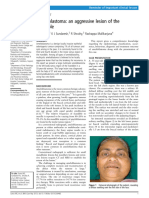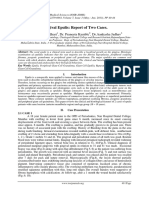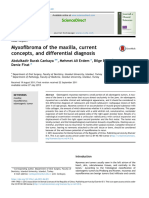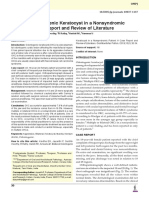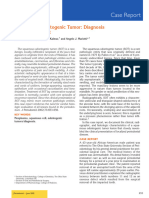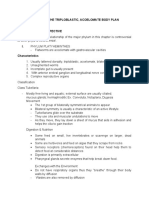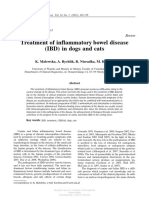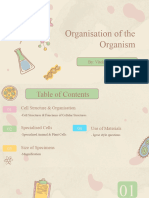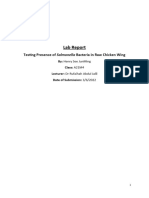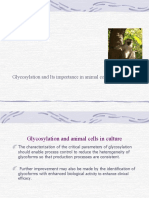Ameloblastic Fibroma: Report of A Case: Su-Gwan Kim, DDS, PHD, and Hyun-Seon Jang, DDS, PHD
Ameloblastic Fibroma: Report of A Case: Su-Gwan Kim, DDS, PHD, and Hyun-Seon Jang, DDS, PHD
Uploaded by
doktergigikoeCopyright:
Available Formats
Ameloblastic Fibroma: Report of A Case: Su-Gwan Kim, DDS, PHD, and Hyun-Seon Jang, DDS, PHD
Ameloblastic Fibroma: Report of A Case: Su-Gwan Kim, DDS, PHD, and Hyun-Seon Jang, DDS, PHD
Uploaded by
doktergigikoeOriginal Title
Copyright
Available Formats
Share this document
Did you find this document useful?
Is this content inappropriate?
Copyright:
Available Formats
Ameloblastic Fibroma: Report of A Case: Su-Gwan Kim, DDS, PHD, and Hyun-Seon Jang, DDS, PHD
Ameloblastic Fibroma: Report of A Case: Su-Gwan Kim, DDS, PHD, and Hyun-Seon Jang, DDS, PHD
Uploaded by
doktergigikoeCopyright:
Available Formats
J Oral Maxillofac Surg 60:216-218, 2002
Ameloblastic Fibroma: Report of a Case
Su-Gwan Kim, DDS, PhD,* and Hyun-Seon Jang, DDS, PhD
Ameloblastic broma (AF) is a relatively rare, slowgrowing, benign odontogenic tumor. It is usually asymptomatic except for the eventual expansion of the jaw.1-3 AF is most common in adolescents and young adults, and is generally found in the mandible. This report describes a 3-year-old girl with AF in the mandible. The differential diagnosis, histology, and treatment are discussed.
vimentin staining was observed in some areas of the immature, dental papilla-like cells and in the basement membrane of the odontogenic epithelium (Figs 3, 4). No tumor was found in the tissue curetted from the surrounding bone. The nal diagnosis was ameloblastic broma. Different areas of the specimen showed different histologic ndings (Figs 5, 6). No calcied dental structures were apparent in the specimen. Areas of mesenchymal tissue without epithelial strands were present, and large areas devoid of ameloblastic strands and dental papilla were also seen (Fig 5). Mesenchymal growth appeared to be more active in areas devoid of epithelium (Fig 6). The postoperative course was uneventful and the patient was discharged for further follow-up. Healing was uneventful and there were no signs of recurrence 22 months after surgery (Fig 7).
Report of a Case
A 3-year-old girl was referred to our hospital on January 22, 1999 after a swelling developed in the right cheek a few days after trauma to that area. Her medical, surgical, family, and social histories were unremarkable. A systemic review was within normal limits, and no medication had been administered. Intraoral examination showed a hard swelling in the right mandibular body. A panoramic radiograph showed a large, multilocular, radiolucent lesion with scalloped margins. It extended from the right rst deciduous molar area to the ascending ramus and coronoid process (Fig 1). The radiograph also revealed expansion of the cortex and resorption of the roots of the lower right second deciduous molar. A displaced, developing permanent rst molar was associated with the lesion. The clinical diagnosis was dentigerous cyst. Enucleation of the lesion, extraction of the lower right permanent rst molar crown, and open packing were performed under general anesthesia. During the surgery, the lesion was found to be encased in bone. It measured 4 3 16 cm, was dark brown, and was soft in consistency. It was removed in pieces and the surrounding bone was curetted. The inferior alveolar nerve was preserved during the procedure and the patient retained normal sensation. Furacin gauze was used as the packing material. Packing was continued for 30 days and the gauze was changed daily. Microscopic examination of the tissue showed the presence of dental lamina-like strands, cords, and nests of odontogenic epithelium within a dental papilla-like myxomatous mesenchymal matrix (Fig 2). Positive cytokeratin staining was seen in the odontogenic epithelium, while positive
Discussion
AF is a relatively rare, benign neoplasm of the group of mixed odontogenic tumors. It represents only 2% of odontogenic tumors.4 It is characterized by the simultaneous proliferation of epithelial and mesenchymal tissue, without the formation of dentin or enamel.5 AF is a true mixed tumor in which both the epithelial and ectomesenchymal elements are neoplastic. There are 2 rare variants: granular cell AF and peripheral AF.6 The precise etiology of AF is not known. However, it is believed to arise de novo during a particular stage of odontogenesis, possibly as a result of overzealous elaboration of the basal lamina without further odontogenic differentiation.7 Trodahl8 reported that in 58% of cases the presenting symptom is swelling. Moreover, there is no significant gender difference in the frequency of AF or race predilection.8 It has been reported as occurring at ages ranging from 6 months to 42 years, with an average from 14.6 to 15.5 years. The youngest patient was a 7-week-old infant reported recently.9,10 Over 80% of these tumors occur in the mandible, usually in the canine-molar region.11,12 Only 4 tumors have been reported in the anterior maxillary region.13 AF exhibits somewhat slower growth than ameloblastoma, and does not tend to inltrate. Instead, it enlarges by gradual expansion so that the periphery of the lesion often remains smooth. The tumors frequently go unnoticed by patients, and are discovered accidentally during radiographic examination. Pain, tenderness, or mild swelling of the jaw may prompt the patient to seek relief from a dentist. In the case presented, the chief complaint was swelling of the cheek. 216
Received from the College of Dentistry, Chosun University, KwangJu, Korea. *Assistant Professor, Department of Oral and Maxillofacial Surgery, Oral Biology Research Institute. Lecturer, Department of Oral Pathology. Address correspondence and reprint requests to Dr Kim: Department of Oral and Maxillofacial Surgery, College of Dentistry, Chosun University, 421, SeoSeogDong, DongKu, KwangJu City, Korea; e-mail: SGCKIM@mail.chosun.ac.kr
2002 American Association of Oral and Maxillofacial Surgeons
0278-2391/02/6002-0017$35.00/0 doi:10.1053/joms.2002.29829
KIM AND JANG
217
FIGURE 1. A panoramic radiograph showing a multilocular osteolytic lesion in the mandibular body and ramus.
FIGURE 2. Dental lamina-like strands, cords, and nests of odontogenic epithelium are seen within a dental papilla-like myxomatous mesenchymal matrix (hematoxylin-eosin stain, original magnication 200).
FIGURE 4. Positive vimentin staining is observed in some immature dental papilla-like cells as well as in the basement membrane of the odontogenic epithelium (original magnication 200).
FIGURE 3. Positive cytokeratin staining is observed in the odontogenic epithelium (original magnication 200).
FIGURE 5. Large areas devoid of ameloblastic strands and dental papilla are seen (hematoxylin-eosin stain, original magnication 40).
218
AMELOBLASTIC FIBROMA: REPORT OF A CASE
FIGURE 6. Active mesenchymal growth is present (hematoxylin-eosin stain, original magnication 100).
Radiographically, AF usually appears as a multilocular radiolucency with sclerotic margins. It typically ranges from 1 to 8 cm in diameter.1 Smaller tumors may appear unilocular, whereas larger ones may extend through the cortices of the bone.1 In the case presented, a multilocular osteolytic image was observed. Histologically, both the epithelial and connective tissue components of AF are neoplastic. The epithelial component is usually in the form of strands and islands, and often has a peripheral layer of cuboidal or columnar cells. The central area resembles the stellate reticulum of the embryonic enamel organ. Mitotic activity is uncommon. In fact, if mitotic activity is readily apparent, particularly in the mesenchymal element, the pathologist should consider the possibility of malignant transformation. The connective tissue component is much more cellular than in ameloblastoma. The cells mimicking the dental papilla or primitive pulp tissue are round or angular, and there is little surrounding collagen. The degree of cellularity
varies within the same tumor and between tumors. A denite capsule is considered an unusual feature of AF. Various immunohistochemical markers of intra and extracellular proteins have been studied in AF and other benign odontogenic mixed tumors. Proliferating cell nuclear antigen and MIB-1 are proteins recently well-recognized in relation to cellular proliferating activity.14 Evaluation of the growth potential in AF and related lesions could be of help in understanding tumor aggressiveness and in selecting appropriate surgical procedures. In the present case, immunohistochemical staining for cytokeratin and vimentin was performed and the tumor cells stained positively. The differential diagnosis includes ameloblastic brosarcoma.15 AF is treated by enucleation and curettage of the surrounding bone and removal of the affected teeth.16 Although recurrence of AF is rare, long-term follow-up is recommended.4 Recurrence is a result of conservative treatment with regrowth of residual tumor, often aided by an attempt to retain involved teeth.
References
1. Cawson RA, Binnie WH, Speight PM, et al: Lucass Pathology of Tumors of the Oral Tissues (ed 5). Hong Kong, Churchill Livingstone, 1998, pp 65-69 2. Shafer WG, Hine MK, Levy BM: A Textbook of Oral Pathology (ed 4). Philadelphia, PA, Saunders, 1983, pp 304-306 3. Regezi JA, Sciubba JJ: Oral Pathology: Clinical-Pathologic Correlations. Philadelphia, PA, Saunders, 1989, pp 393-394 4. Blankestijn J, Panders AK, Wymenga JP: Ameloblastic broma of the mandible. Br J Oral Maxillofac Surg 24:417, 1986 5. Regezi JA, Kerr DA, Courtney RM: Odontogenic tumours:Analysis of 706 cases. J Oral Surg 36:771, 1978 6. Takeda Y: Ameloblastic broma and related lesions: Current pathologic concept. Oral Oncol 35:535, 1999 7. Eversole LE, Tomich CE, Cherrick HM: Histogenesis of odontogenic tumors. Oral Surg 32:569, 1971 8. Trodahl JN: Ameloblastic broma: A survey of cases from the Armed Forces Institute of Pathology. Oral Surg 33:547, 1972 9. Slootweg PJ: An analysis of the interrelationships of the mixed odontogenic tumors: Ameloblastic broma, ameloblastic broodontoma and the odontomas. Oral Surg 51:266, 1981 10. Mosby EL, Russel D, Noren S, et al: Ameloblastic broma in a 7-week-old infant: A case report and review of the literature. J Oral Maxillofac Surg 56:368, 1998 11. Zallen RD, Preskar MH, McClary SA: Ameloblastic broma. J Oral Maxillofac Surg 40:513, 1982 12. Young AH: Ameloblastic broma in an infant. J Oral Maxillofac Surg 43:289, 1985 13. Heringer WW: Ameloblastic broma in an anterior maxilla: Report of a case. J Dent Child 45:408, 1978 14. Yamamoto K, Yoneda K, Yamamoto T, et al: An immunohistochemical study of odontogenic mixed tumors. Oral Oncol 31:122, 1995 15. Leider AS, Nelson JF, Trodahl JN: Ameloblastic brosarcoma of the jaws. Oral Surg Oral Med Oral Pathol 33:559, 1972 16. Dallera P, Bertoni F, Marchetti C, et al: Ameloblastic broma: A follow-up of six cases. Int J Oral Maxillofac Surg 25:199, 1996
FIGURE 7. A postoperative panoramic radiograph showing no evidence of recurrence 22 months after surgery.
You might also like
- Biology Investigatory ProjectDocument19 pagesBiology Investigatory ProjectRapidtg 196591% (11)
- Satnam Sir LeioDocument15 pagesSatnam Sir LeiobubblyNo ratings yet
- Ameloblastic Fibro-Dentinoma of Mandible: A Case ReportDocument3 pagesAmeloblastic Fibro-Dentinoma of Mandible: A Case ReportBrutusRexNo ratings yet
- Follicular With Plexiform Ameloblastoma in Anterior Mandible: Report of Case and Literature ReviewDocument6 pagesFollicular With Plexiform Ameloblastoma in Anterior Mandible: Report of Case and Literature Reviewluckytung07No ratings yet
- Peripheral Ameloblastic FibromaDocument3 pagesPeripheral Ameloblastic FibromadoktergigikoeNo ratings yet
- Cabt 12 I 6 P 244Document4 pagesCabt 12 I 6 P 244Ezza RiezaNo ratings yet
- Tumor Odontogenico EscamosoDocument4 pagesTumor Odontogenico Escamosoメカ バルカNo ratings yet
- Case Report Ameloblastic Fibroma: Report of 3 Cases and Literature ReviewDocument5 pagesCase Report Ameloblastic Fibroma: Report of 3 Cases and Literature ReviewcareNo ratings yet
- JPNR - S04 - 233Document6 pagesJPNR - S04 - 233Ferisa paraswatiNo ratings yet
- Jurnal Ameloblastoma 1Document3 pagesJurnal Ameloblastoma 1riezki_amalia8No ratings yet
- Odontogenic Myxoma in A Child: Diagnostic and Treatment DilemmasDocument5 pagesOdontogenic Myxoma in A Child: Diagnostic and Treatment DilemmasthedocperuNo ratings yet
- Odontogenic FibromaDocument5 pagesOdontogenic FibromaGowthamChandraSrungavarapuNo ratings yet
- Juvenile Ossifying Fibroma: ASE EportDocument3 pagesJuvenile Ossifying Fibroma: ASE Eportsagarjangam123No ratings yet
- Calcifying Epithelial Odontogenic Pindborg Tumor of T 2005 Journal of OralDocument6 pagesCalcifying Epithelial Odontogenic Pindborg Tumor of T 2005 Journal of OralDavid MonroyNo ratings yet
- Ameloblastic Carcinoma - Report of A New Case, Literature Review, and Comparison To AmeloblastomaDocument7 pagesAmeloblastic Carcinoma - Report of A New Case, Literature Review, and Comparison To AmeloblastomaTayyaba RafiqNo ratings yet
- Ameloblastic Fibro-Odontoma: A Case ReportDocument4 pagesAmeloblastic Fibro-Odontoma: A Case Reportoral pathNo ratings yet
- Leiyomosarcoma of The Oral Cavity in Pediatric PatientDocument13 pagesLeiyomosarcoma of The Oral Cavity in Pediatric PatientbubblyNo ratings yet
- Squamous Cell Carcinoma of The Mandibular Gingiva: Pei-Yu Li, DDS Ling Auyeung, DDS, MS Shun-Chen Huang, MDDocument5 pagesSquamous Cell Carcinoma of The Mandibular Gingiva: Pei-Yu Li, DDS Ling Auyeung, DDS, MS Shun-Chen Huang, MDtsntiNo ratings yet
- IJRID28Document10 pagesIJRID28Saurabh SatheNo ratings yet
- Saudi Journal of Pathology and Microbiology (SJPM) : Case ReportDocument3 pagesSaudi Journal of Pathology and Microbiology (SJPM) : Case ReportSuman ChaturvediNo ratings yet
- dmf2SA Presentasi01Document5 pagesdmf2SA Presentasi01Iftinan LQNo ratings yet
- Mandibular Ameloblastoma in A 10-Year-Old Child: Case Report and Review of The LiteratureDocument6 pagesMandibular Ameloblastoma in A 10-Year-Old Child: Case Report and Review of The LiteratureWidhi Satrio NugrohoNo ratings yet
- 55-Submission File-100-1-10-20190812Document4 pages55-Submission File-100-1-10-20190812I Dewa Wisnu PutraNo ratings yet
- Review Article: Pathogenesis OF Odontogenic Tumors OF Epithelial Origin-A ReviewDocument10 pagesReview Article: Pathogenesis OF Odontogenic Tumors OF Epithelial Origin-A ReviewIzzati Aqmar DarayaniNo ratings yet
- Peripheral Squamous Odontogenic Tumor: Hort OmmunicationDocument4 pagesPeripheral Squamous Odontogenic Tumor: Hort OmmunicationGreisy Saym Cruz FelixNo ratings yet
- Cabt 12 I 3 P 330Document4 pagesCabt 12 I 3 P 330abeer alrofaeyNo ratings yet
- Ameloblastoma of Sinonasal Origin:a Rare EntityDocument4 pagesAmeloblastoma of Sinonasal Origin:a Rare EntityAmitSharmaNo ratings yet
- Condylar AbnormalityDocument8 pagesCondylar AbnormalityPoornima SoujanyaNo ratings yet
- Bilateral Adenomatoid Odontogenic Tumour of The Maxilla in A 2-Year-Old Female-The Report of A Rare Case and Review of The LiteratureDocument7 pagesBilateral Adenomatoid Odontogenic Tumour of The Maxilla in A 2-Year-Old Female-The Report of A Rare Case and Review of The LiteratureStephanie LyonsNo ratings yet
- AmeloblastomaDocument6 pagesAmeloblastomaNASTYHAIR 24No ratings yet
- 4 Ads 16 112 PDFDocument4 pages4 Ads 16 112 PDFJeyachandran MariappanNo ratings yet
- Li Tiejun2006Document8 pagesLi Tiejun2006Herpika DianaNo ratings yet
- 1 s2.0 S2214541921000055 MainDocument8 pages1 s2.0 S2214541921000055 MainreyesivangarciacuevasNo ratings yet
- Odontogenic FibromaDocument11 pagesOdontogenic FibromaDan DiverNo ratings yet
- Clinical: Peripheral Ossifying Fibroma: A Case ReportDocument4 pagesClinical: Peripheral Ossifying Fibroma: A Case Reportsagarjangam123No ratings yet
- Adenoid Cystic Carcinoma of Hard Palate: A Case ReportDocument5 pagesAdenoid Cystic Carcinoma of Hard Palate: A Case ReportHemant GuptaNo ratings yet
- Primary Ameloblastic Carcinoma of The Maxilla A CaDocument9 pagesPrimary Ameloblastic Carcinoma of The Maxilla A CaMuhammad Avicenna AdjiNo ratings yet
- Lucrare Stiintifica ParodontologieDocument4 pagesLucrare Stiintifica ParodontologieReduceriAvonNo ratings yet
- Ameloblastoma: Notorious Tumor of The Jaw - Report of A CaseDocument3 pagesAmeloblastoma: Notorious Tumor of The Jaw - Report of A CaseUwie MoumootNo ratings yet
- AmeloDocument5 pagesAmelobayyin.laily.nurrahmi-2022No ratings yet
- Gingival Epulis: Report of Two Cases.: Dr. Praful Choudhari, Dr. Praneeta KambleDocument5 pagesGingival Epulis: Report of Two Cases.: Dr. Praful Choudhari, Dr. Praneeta KambleAnandNo ratings yet
- Calcifying Epithelial Odontogenic Tumor - A CaseDocument5 pagesCalcifying Epithelial Odontogenic Tumor - A CaseKharismaNisaNo ratings yet
- Calcifying Epithelial Odontogenic Tumor - A Case Series Spanning 25 Years and Review of The LiteratureDocument10 pagesCalcifying Epithelial Odontogenic Tumor - A Case Series Spanning 25 Years and Review of The Literaturesyifa qushoyyiNo ratings yet
- Osteosarcoma of Mandible: Abst TDocument3 pagesOsteosarcoma of Mandible: Abst TTriLightNo ratings yet
- Central Giant Cell Granuloma A Potential Endodontic MisdiagnosisDocument3 pagesCentral Giant Cell Granuloma A Potential Endodontic MisdiagnosisDr.O.R.GANESAMURTHINo ratings yet
- BrazJOralSci 2007 Vol6 Issue21 p1364Document3 pagesBrazJOralSci 2007 Vol6 Issue21 p1364Inesza Sylviane AndariNo ratings yet
- Management of Unicystic Ameloblastoma Crossing Midline in Mandible in Geriatric Patient - July - 2020 - 9370586511 - 3513376Document3 pagesManagement of Unicystic Ameloblastoma Crossing Midline in Mandible in Geriatric Patient - July - 2020 - 9370586511 - 3513376Sowmya ManthaNo ratings yet
- Pleomorphic Adenoma of The Palate: Clinicoradiological Case ReportDocument3 pagesPleomorphic Adenoma of The Palate: Clinicoradiological Case Reportsarah iriamanaNo ratings yet
- 2017 ReviewDocument4 pages2017 ReviewmaomaochongNo ratings yet
- Osseous Choristoma of The Periodontium: Case ReportDocument3 pagesOsseous Choristoma of The Periodontium: Case ReportAndykaYayanSetiawanNo ratings yet
- 8Document10 pages8veliaisabelvelazquezNo ratings yet
- Giant Cell Epulis: Report of 2 Cases.: Oral PathologyDocument11 pagesGiant Cell Epulis: Report of 2 Cases.: Oral PathologyVheen Dee DeeNo ratings yet
- 333 FullDocument6 pages333 FullImara BQNo ratings yet
- Lateral Periodontal CystDocument8 pagesLateral Periodontal CystTejas KulkarniNo ratings yet
- Case Report The Challenging Diagnosis of Primordial Odontogenic TumorDocument5 pagesCase Report The Challenging Diagnosis of Primordial Odontogenic Tumorlee zaraNo ratings yet
- Ijcmr 692 Jun 14Document2 pagesIjcmr 692 Jun 14Jeyachandran MariappanNo ratings yet
- Bilateral Odontogenic Keratocyst in A NonsyndromicDocument5 pagesBilateral Odontogenic Keratocyst in A NonsyndromicRocio CacñahuarayNo ratings yet
- 2019 Article 867Document8 pages2019 Article 867Reyes Ivan García CuevasNo ratings yet
- Case Report: DiscussionDocument2 pagesCase Report: DiscussionAlfonsius JeriNo ratings yet
- Tumor Diagnosis ManagementDocument4 pagesTumor Diagnosis ManagementNajmaldeen AbdualhafeezNo ratings yet
- Temporal Bone CancerFrom EverandTemporal Bone CancerPaul W. GidleyNo ratings yet
- CBS Scientific Electrophoresis Catalog WestburgDocument60 pagesCBS Scientific Electrophoresis Catalog WestburgHồ Từ Thu TrangNo ratings yet
- Soal SBMPTNDocument7 pagesSoal SBMPTNbintang pamungkasNo ratings yet
- Dna HWDocument9 pagesDna HWMelis SertNo ratings yet
- Chapter 8: The Triploblastic, Acoelomate Body PlanDocument5 pagesChapter 8: The Triploblastic, Acoelomate Body PlanJiboy MixNo ratings yet
- PterisDocument12 pagesPterisLINTA JOSEPH100% (2)
- Malewska 2011Document6 pagesMalewska 2011pugetvivianneNo ratings yet
- Bio Unit 2Document25 pagesBio Unit 2benlucag5No ratings yet
- Homoeopathy in GeriatricsDocument62 pagesHomoeopathy in GeriatricsKangal100% (4)
- 054 - Endocrinology Physiology) Pancreas Insulin FunctionDocument4 pages054 - Endocrinology Physiology) Pancreas Insulin FunctionLily Blossom100% (1)
- National Institute of Biomedical Imaging and Bioengineering: What Are Drug Delivery Systems?Document2 pagesNational Institute of Biomedical Imaging and Bioengineering: What Are Drug Delivery Systems?Irina RinnaNo ratings yet
- ReferencesDocument32 pagesReferencesLususNo ratings yet
- Brian Perry: Cosmetic MicrobiologyDocument3 pagesBrian Perry: Cosmetic MicrobiologyNukiAdelaNo ratings yet
- Food Energy Pyramid Do Now ReadingDocument2 pagesFood Energy Pyramid Do Now Readingapi-291011460No ratings yet
- Biochemistry of Ammonia AssimilationDocument15 pagesBiochemistry of Ammonia AssimilationbenonNo ratings yet
- 01 Plant Kingdom - 21-03-2024Document9 pages01 Plant Kingdom - 21-03-2024vedangjoshi882007No ratings yet
- Wa0045Document96 pagesWa0045Nasser HashimNo ratings yet
- Biology Specimen Papers 2016Document115 pagesBiology Specimen Papers 2016Olga KaczmarekNo ratings yet
- Kimok Science Doodles Style Infographics Daily Learning StemDocument34 pagesKimok Science Doodles Style Infographics Daily Learning Stem20049 rofiqo aroyaNo ratings yet
- Biotech EssayDocument2 pagesBiotech EssayPatel SuraiyaNo ratings yet
- Henry See 2102515J A21M4 MDT Lab ReportDocument12 pagesHenry See 2102515J A21M4 MDT Lab ReportHenry SeeNo ratings yet
- Conference of The Romanian Association of Laboratory Medicine With International ParticipationDocument18 pagesConference of The Romanian Association of Laboratory Medicine With International ParticipationaurelghitaNo ratings yet
- Assignment # 1: CHE 438: Biochemical Engineering Batch: FA18-CHE Section ADocument3 pagesAssignment # 1: CHE 438: Biochemical Engineering Batch: FA18-CHE Section AMOHAMMAD TABISH LATIFNo ratings yet
- PIIS2211124722005289Document22 pagesPIIS2211124722005289LisaNo ratings yet
- Human Growth HormoneDocument31 pagesHuman Growth HormoneGhadeer Jad100% (2)
- Osmosis: Osmosis Is The Spontaneous Net Movement of SolventDocument3 pagesOsmosis: Osmosis Is The Spontaneous Net Movement of SolventCHIEF VISHAAL 45No ratings yet
- The Dermis, Subcutaneous Layer and Appendages of The Skin: S/NVQ Level 2Document8 pagesThe Dermis, Subcutaneous Layer and Appendages of The Skin: S/NVQ Level 2mahesh0926No ratings yet
- Summative Test Science 10Document3 pagesSummative Test Science 10Zaifel Pacillos100% (2)
- Grading Rubric For DNA ModelDocument2 pagesGrading Rubric For DNA ModelDebbie Ann LaguindabNo ratings yet
- Nutritional Requirements of Animal Cells in Culture-SerumDocument51 pagesNutritional Requirements of Animal Cells in Culture-SerumMahesh Aithal0% (1)
